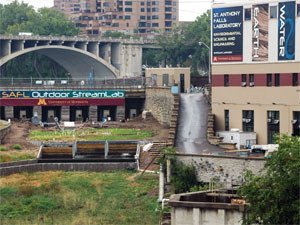St. Anthony Falls Lab expands to become collegewide research center

Contacts:
Rhonda Zurn, College of Science and Engineering, rzurn@umn.edu, (612) 626-7959
Preston Smith, University News Service, smith@umn.edu, (612) 625-0552
MINNEAPOLIS / ST. PAUL (07/1/2011) — With new initiatives, expansion into additional research areas, and strengthened relationships across disciplines, the University of Minnesota St. Anthony Falls Laboratory (SAFL) is now a research facility of the College of Science and Engineering. The change was effective July 1, 2011.
Historically, SAFL had been part of the Department of Civil Engineering and affiliated with the Department of Earth Sciences (formerly the Department of Geology and Geophysics) as well as the Department of Ecology, Evolution and Behavior in the College of Biological Sciences. Now as part of the College of Science and Engineering, a new administrative structure provides many more opportunities for faculty from all College of Science and Engineering departments and the entire University to interact with and become part of the laboratory.
“We’re excited by the opportunity for the laboratory’s unique resources and expertise to be used to strengthen research collaborations and create new opportunities within the college and the University,” said Fotis Sotiropoulos, director of SAFL. “This transition is the result of the hard work and academic excellence of our faculty, staff and students. They are the ones who helped establish the lab as a major hub for research in energy and environment within the University of Minnesota.”
Founded in the 1930s as a hydraulics lab, the role of the SAFL has expanded significantly during recent years. SAFL has been able to increase its affiliations with other departments at the University of Minnesota due to major initiatives such as the NSF-funded National Center for Earth-surface Dynamics (NCED) and the Department of Energy-funded EOLOS wind energy research consortium, as well as expansion into new research in areas such as biofuels, marine and hydrokinetic energy, and medical devices.
“This is a new chapter in SAFL’s history,” said Steve Crouch, the dean of the College of Science and Engineering. “It will not only help sustain and expand the research activities of this historic research facility but it will also create exciting new interdisciplinary research and educational opportunities for many of our students and faculty.”
